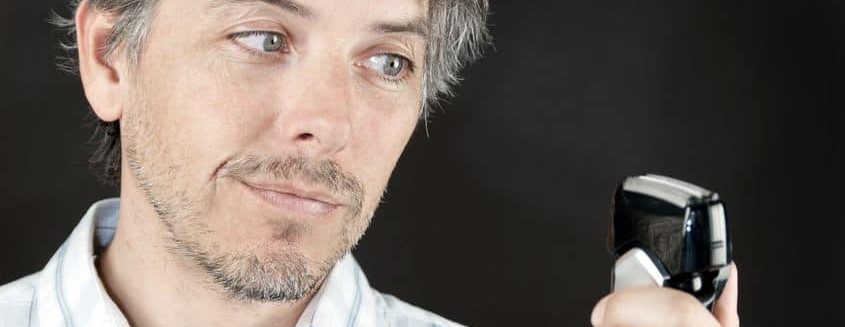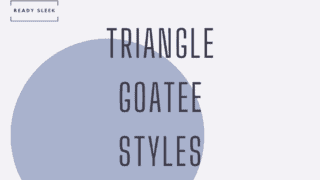It has grown in popularity over recent years but is still quite uncommon to come across. This makes it an interesting one to wear if you were looking for a way to stand out. But what exactly is the goatee with stubble?
It’s a fantastic combination of a goatee and a stubble beard. A typical goatee is sculpted with hair on the chin and mustache.
However, instead of shaving everything outside of this outline, surrounding hairs are trimmed down to stubble instead.
Due to its uniqueness, the style often turns heads and draws attention. It’s simple, yet stylish and intensely rugged. Men who adopt it also have the added benefit of not having to shave as much as regularly goateed men.
What I wanted to do is get into this style a little deeper. First, I’ll go into what the style really consists of in more detail. I don’t want there to be any confusion here.
What Is The Goatee With Stubble
As I said earlier, the clearest way to visualize this style is to see it as a combination of a goatee and a stubble beard.
A goatee historically refers to hair on the chin, but not on the cheeks. Since the 1990s, goatees have routinely incorporated mustaches as well.
The typical “goatee” nowadays consists of hair on the chin connected to a mustache. In this way, it appears to encircle the beard.
Of course, there are goatee variants that don’t match this description exactly. For example, “anchor” goatees, and the Van Dyke. In these styles, the mustache doesn’t connect to the chin beard.
But in all of them, there is never any hair on the cheeks. It’s always shaved off.
“Stubble” refers to facial hair that is less than 5mm long. It doesn’t matter if it’s light, medium, or heavy stubble. It should only refer to hair that is shorter than 5mm.
Putting these two styles together would result in a goatee beard with surrounding stubble on the cheeks.
For the style to work, the goatee beard would have to be longer than the surrounding stubble in order to make it more prominent and visible.
Here’s what it looks like:

So, instead of shaved cheeks, you simply have stubbled cheeks instead. The stubble adds intensity and masculinity to the style that would be difficult to achieve with a regular goatee.
It’s important not to confuse the “goatee with stubble” with a “stubble goatee”. They definitely aren’t the same thing. A stubble goatee is simply a goatee beard that is shorter than 5mm long. The hair on the cheeks is shaved, and not trimmed down to stubble.
How To Trim The Goatee With Stubble
What I love most about this style is how straightforward it is to achieve. I’ve created a brief, step-by-step tutorial on how to trim it. Here it is:
1. Trim the whole beard down to goatee length
You will need an electric trimmer to do this. Ideally, a stubble trimmer that gives you more intricate control over length. For example, the Philips Norelco Oneblade QP6520/70 – check it out on
The goatee length is the length you eventually want the goatee area to be. Remember, in order for the “goatee with stubble” style to work the goatee hair needs to be longer than the stubble on the cheeks.
The difference in length between the goatee and the stubble can be something you experiment with. However, having the goatee 5mm longer than the stubble should produce the desired effect.
2. Define the goatee outline
In this example, I’m going to trim the typical goatee consisting of hair on the chin, connected to the mustache. I’ll also be leaving a little soul patch just immediately beneath my bottom lip.
This specific goatee shape has a couple of different names. Some call it a “full goatee”, and others may call it a “circle beard”.
So, I’ll now want to create a rough outline of the goatee by trimming around it. The surrounding areas (cheek and neck) will be trimmed down to the stubble length. In this example, that would be to 3mm.
When trimming a goatee, a common rookie error is to trim the sides vertically downwards from the corners of the mouth. The sides of a goatee should have a natural curve.
Make the goatee slightly wider than you’d first expect. If you overshoot, you might make it too narrow. Making it wider to begin with gives you the option of carefully narrowing it down afterward.

From Shutterstock
3. Shape the goatee more precisely
You may not feel that this is necessary. You may feel as though your goatee as it stands is precise enough. If that’s the case, it’s fine. Move on to the next step.
But if you want to sharpen up the goatee outline, consider the following.
Your trimmer may come with a specific precision or “edging” blade – use this if it’s available. I use the naked blade of my trimmer (with no guard attached).
Step 5. Define the neckline further
You’ve hopefully made a point to leave enough of your goatee neckline as per step 3.
It’s now time to define that neckline further by getting rid of that “neck stubble”. Neck stubble never looks tidy.
The quickest way to do this would be with a razor or an electric shaver. Simply define that neckline further by shaving any neck stubble that lies beneath it.
Remember, the neckline should look natural. Leave it at two-finger widths above your Adam’s apple, roughly following the angle of the jaw to either side. It should consist of goatee hair in the middle and stubble hair to either side.

Benefits Of The Goatee With Stubble
The style has plenty going for it. But three features stand out more than others.
1. It’s great for patchy cheeks
The number of men who give up on their beards because of patchiness in the cheeks is alarmingly high. Unfortunately, it is a very common problem.
Hair just tends to run thin over the cheeks. In contrast, the mustache and chin beard are usually blessed with density.
The reason this style is able to compensate for this weakness is that it emphasizes the thick areas while masking the thin areas.
The typically thin cheek areas are trimmed down to stubble. Patchiness is often less obvious when the hair is trimmed down so short.
The thicker mustache and chin areas comprise the main part of the goatee, and so are left alone to shine front-and-center.
In summary, if you’ve got a patchy cheek beard – try the goatee with stubble style.
2. You’ll have to shave less
Goatees are great. They’re neat, compact, and versatile. However, many men find that the amount of shaving necessary for its upkeep is a downside.
In a “normal” goatee style, the cheeks are shaved and not trimmed to stubble. This shaving will also have to be done at least every couple of days to keep it looking tidy.
3. It’s stylish
Stubble will always be considered rugged. It’s been called the most attractive beard length and for good reason.
Neatly groomed stubble is difficult to beat in terms of versatility and universal acceptance. People love it.
Its uniqueness is always going to turn heads. If you’re looking for a style that works but isn’t very common, this one may be well worth considering.
Conclusion
Blending two well-established, distinct facial hairstyles is always going to produce interesting results. This hybrid is an especially effective one.
Hopefully, you’ve got a much better understanding of what it really is. You’ve gotten a taste for what it looks like, why it works, and how to achieve it in the most stylish way possible.
Ready Sleek founder. Obsessed with casual style and the minimalist approach to building a highly functional wardrobe. Also a fan of classic, vintage hairstyles.







